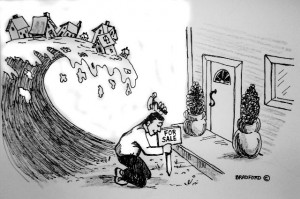 Two years ago, foreclosures in the United States were taking place at an alarming pace. The American housing market had collapsed a few years before, eventually leading to the global financial crisis. As hundreds of thousands of unemployed borrowers defaulted on their mortgages, lenders quickly moved to evict them until an investigation revealed questionable and unethical practices that forced them to slow down the pace of foreclosures.
Two years ago, foreclosures in the United States were taking place at an alarming pace. The American housing market had collapsed a few years before, eventually leading to the global financial crisis. As hundreds of thousands of unemployed borrowers defaulted on their mortgages, lenders quickly moved to evict them until an investigation revealed questionable and unethical practices that forced them to slow down the pace of foreclosures.
After the five major mortgage lenders in the U.S. agreed to participate in a historical settlement to redress their dubious foreclosure practices, mortgage experts and housing analysts worried that the pace of evictions and repossessions would pick up once again. Fears of a reopening of the foreclosure floodgates worried real estate industry observers who were concerned about the potential damage to the burgeoning housing recovery.
A Tragedy Avoided
Instead of a torrent of foreclosures, some housing markets are actually experiencing a low supply of homes available to purchase. Such is the case of Stockton in California. According to a recent article in financial news outlet Bloomberg, Stockton may still be notorious for its high rate of foreclosures, but it is also facing a shortage of real estate listings.
The sales activity and price appreciation of the last 12 months in Stockton has many investors wishing for multiple foreclosures to come on the market and meet the hunger for real estate deals. Should this happen, it would be a windfall for investors looking to take advantage of rock-bottom prices, but it would also erase gains in the housing market realized over the last few months. It would be a tragedy for the Stockton housing market, but it has thus far been deflected.
As part of the landmark mortgage foreclosure settlement agreement, mortgage lenders and servicing banks are carefully reviewing their pending foreclosures. They are taking their time, and in some cases they are writing down principal balances and offering loan modifications. Instead of rushing through foreclosures, they are patiently slowing down the process.
Staying in the Shadows
The current shadow inventory, those properties pending foreclosures or in a state of financial distress, may be greater than the amount of available real estate listings. This has been a source of consternation in the past, but recent reports releases by the Mortgage Bankers Association indicate that the shadow inventory is falling at a gradual pace.
As long as distressed properties coming out of the shadows do not hit the market too soon, the negative impact on the housing recovery could be negligible. Between short sales, mortgage modifications and write downs, housing markets like Stockton will emerge from being known for their high foreclosure rates to being examples of the nascent real estate recovery.



